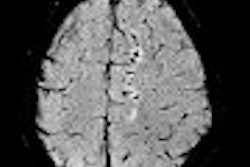Advances in multidetector CT technology may prove a boon to India's growing population, which has shown a ninefold increase in coronary artery disease (CAD) from the 1960s to the 1990s. And the disease is increasingly occurring in women. Figures for urban India show an 11% overall prevalence of the disease, with a 14.8% prevalence rate for women compared to 6.2% for men.
"Sudden death is the first and last sign of CAD in 150,000 people a year. Then you realize the importance of knowing the status of your coronary arteries," said Dr Shrinivas B. Desai, delivering the keynote address at Imaging Update - 2004 at the Armed Forces Medical College in Pune. Desai is the editor in chief of the Indian Journal of Radiology and Imaging and Hon. Radiologist at Jaslok Hospital in Mumbai.
Quoting the U.K.'s Royal College of Radiologists, Desai advocated baseline coronary CT angiography (CTA) for all high-risk patients to exclude the possibility of an abnormal coronary artery.
He listed CTA as one of the newer imaging techniques that has made an impact on everyday clinical practice. The technique scores over conventional coronary angiography because of its ability to characterise plaque.
Soft plaque, which is rupture-prone, cannot be visualised during cardiac catheterisation unless the narrowing is significant. But plaques can be characterised based on CT attenuation, making CTA the only noninvasive study that can visualise vulnerable plaque. Lipid plaques typically have a Hounsfield unit (HU) density below 50, fibrous plaque between 50 and 130, and calcified plaque greater than 130.
According to Desai, 90% of acute myocardial infarcts do not show significant coronary artery stenosis. In addition, he said, Indians have smaller coronaries than other communities, making the arteries prone to narrowing, and making scans more of a necessity for high-risk groups.
However, CTA as a modality is not optimal to assess stent narrowing in heavily calcified arteries because what is visualised is primarily the difference in the densities between the two structures, he said.
Among the other imaging techniques Desai categorised as having a significant impact on clinical practice was MR cholangiopancreaticography (MRCP), which has largely replaced endoscopic retrograde cholangiopancreatography (ERCP) except for interventional procedures.
For stroke, which affects a large number of adults with disability, Desai said the challenge was to visualise the ischemic penumbra and identify the difference between salvageable, nonsalvageable, and undamaged brain tissue. It must be done in the shortest possible time because the therapeutic window is only three to six hours after the onset of symptoms.
This can be done using diffusion and perfusion MRI or quantitative perfusion CT imaging. Perfusion parameters, cerebral blood volume (CBV), cerebral blood flow (CBF), and mean transit time (MTT) show whether the tissue is viable or infarcted. In case of infarct, the CBV and CBF are decreased. For ischaemia, the CBV is increased or normal but with decreased CBF.
On emerging imaging techniques, Desai said MR histopathology, with images similar to histopathology slides, could well become the discovery of the century. "Radiology will be then taken over by the pathologists," he joked.
By N. Shivapriya
AuntMinnieIndia.com staff writer
September 20, 2004
Copyright © 2004 AuntMinnie.com



















